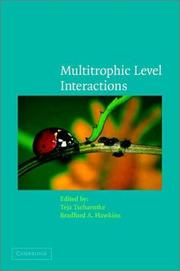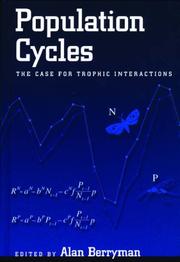| Listing 1 - 6 of 6 |
Sort by
|
Book
Year: 2002 Publisher: Seattle, WA : U.S. Dept. of Commerce, National Oceanic and Atmospheric Administration, National Marine Fisheries Service, Alaska Fisheries Science Center,
Abstract | Keywords | Export | Availability | Bookmark
 Loading...
Loading...Choose an application
- Reference Manager
- EndNote
- RefWorks (Direct export to RefWorks)
Food chains (Ecology) --- Marine ecology --- Biotic communities.
Book
Year: 2002 Publisher: Seattle, WA : U.S. Dept. of Commerce, National Oceanic and Atmospheric Administration, National Marine Fisheries Service, Alaska Fisheries Science Center,
Abstract | Keywords | Export | Availability | Bookmark
 Loading...
Loading...Choose an application
- Reference Manager
- EndNote
- RefWorks (Direct export to RefWorks)
Food chains (Ecology) --- Marine ecology --- Biotic communities.

ISBN: 0521791103 9780521791106 0511067194 9780511067198 0511069324 9780511069321 0511170521 9780511170522 1280418176 9781280418174 9780511542190 0511542194 9780521084185 0521084180 1107129672 9786610418176 1139146793 0511060882 0511297580 Year: 2002 Publisher: Cambridge : Cambridge University Press,
Abstract | Keywords | Export | Availability | Bookmark
 Loading...
Loading...Choose an application
- Reference Manager
- EndNote
- RefWorks (Direct export to RefWorks)
The multitrophic level approach to ecology addresses the complexity of food webs much more realistically than the traditional focus on simple systems and interactions. Only in the last few decades have ecologists become interested in the nature of more complex systems including tritrophic interactions between plants, herbivores and natural enemies. Plants may directly influence the behaviour of their herbivores' natural enemies, ecological interactions between two species are often indirectly mediated by a third species, landscape structure directly affects local tritrophic interactions and below-ground food webs are vital to above-ground organisms. The relative importance of top-down effects (control by predators) and bottom-up effects (control by resources) must also be determined. These interactions are explored in this exciting volume by expert researchers from a variety of ecological fields. This book provides a much-needed synthesis of multitrophic level interactions and serves as a guide for future research for ecologists of all descriptions.
Multitrophic interactions (Ecology). --- Environmental Sciences and Forestry. Environmental Management --- Environmental Protection. --- ecosystems --- Animal population --- plant population --- Biological competition --- Multitrophic interactions (Ecology) --- Interactions, Multitrophic (Ecology) --- Food chains (Ecology)

ISBN: 0691074879 0691074860 140084729X 1299051472 9781400847297 9780691074870 9780691074863 9780691074870 Year: 2002 Volume: 34 Publisher: Princeton, N.J. : Princeton University Press,
Abstract | Keywords | Export | Availability | Bookmark
 Loading...
Loading...Choose an application
- Reference Manager
- EndNote
- RefWorks (Direct export to RefWorks)
Most of the earth's terrestrial species live in the soil. These organisms, which include many thousands of species of fungi and nematodes, shape aboveground plant and animal life as well as our climate and atmosphere. Indeed, all terrestrial ecosystems consist of interdependent aboveground and belowground compartments. Despite this, aboveground and belowground ecology have been conducted largely in isolation. This book represents the first major synthesis to focus explicitly on the connections between aboveground and belowground subsystems--and their importance for community structure and ecosystem functioning. David Wardle integrates a vast body of literature from numerous fields--including population ecology, ecosystem ecology, ecophysiology, ecological theory, soil science, and global-change biology--to explain the key conceptual issues relating to how aboveground and belowground communities affect one another and the processes that each component carries out. He then applies these concepts to a host of critical questions, including the regulation and function of biodiversity as well as the consequences of human-induced global change in the form of biological invasions, extinctions, atmospheric carbon-dioxide enrichment, nitrogen deposition, land-use change, and global warming. Through ambitious theoretical synthesis and a tremendous range of examples, Wardle shows that the key biotic drivers of community and ecosystem properties involve linkages between aboveground and belowground food webs, biotic interaction, the spatial and temporal dynamics of component organisms, and, ultimately, the ecophysiological traits of those organisms that emerge as ecological drivers. His conclusions will propel theoretical and empirical work throughout ecology.
General ecology and biosociology --- Food chains (Ecology) --- Soil ecology. --- Environmental Sciences and Forestry. Ecology --- Ecology (General) --- Food chains (Ecology). --- Ecology (General). --- Food webs (Ecology) --- Edaphology --- Animals --- Biological productivity --- Ecology --- Niche (Ecology) --- Nutrient cycles --- Soils --- Roots (Botany) --- Food --- Environmental aspects --- Trophic ecology

ISBN: 0197561756 1280834986 9786610834983 0195349733 9780195349733 0195140982 9780195140989 Year: 2002 Publisher: Oxford ; New York : Oxford University Press,
Abstract | Keywords | Export | Availability | Bookmark
 Loading...
Loading...Choose an application
- Reference Manager
- EndNote
- RefWorks (Direct export to RefWorks)
For over sixty years, understanding the causes of multiannual cycles in animal populations has been a central issue in ecology. This book brings together ten of the leaders in this field to examine the major hypotheses and recent evidence in the field, and to establish that trophic interactions are an important factor in driving at least some of the major regular oscillations in animal populations that have long puzzled ecologists.
Animal populations. --- Food chains (Ecology) --- Demography, Wildlife --- Populations, Animal --- Wildlife demography --- Wildlife populations --- Animal ecology --- Population biology --- Food webs (Ecology) --- Trophic ecology --- Animals --- Ecology --- Nutrient cycles --- Food --- Animal ecology. --- Zoology

ISBN: 9780226668321 0226668320 Year: 2002 Publisher: Chicago University of Chicago Press
Abstract | Keywords | Export | Availability | Bookmark
 Loading...
Loading...Choose an application
- Reference Manager
- EndNote
- RefWorks (Direct export to RefWorks)
"Although it was first published twenty years ago, Stuart Pimm's Food Webs remains the clearest introduction to the study of the subject. Reviewing various hypotheses in the light of theoretical and empirical evidence, Pimm shows that even the most complex food webs follow certain patterns and that those patterns are shaped by a limited number of biological processes, such as population dynamics and energy flow. Pimm provides a variety of mathematical tools for unravelling these patterns and processes, and demonstrates their application through concrete examples. For this edition, Pimm has written a new foreword covering recent developments in the study of food webs and their continuing importance to conservation biology."--Jacket.
General ecology and biosociology --- Nutritionary hygiene. Diet --- Food chains (Ecology) --- Biotic communities --- 664.8 --- 664.8 Preservation of organic edible substances (in general). Preservation of plant, vegetable products --- Preservation of organic edible substances (in general). Preservation of plant, vegetable products --- Biocenoses --- Biocoenoses --- Biogeoecology --- Biological communities --- Biomes --- Biotic community ecology --- Communities, Biotic --- Community ecology, Biotic --- Ecological communities --- Ecosystems --- Natural communities --- Ecology --- Population biology --- Food webs (Ecology) --- Trophic ecology --- Animals --- Nutrient cycles --- Food
| Listing 1 - 6 of 6 |
Sort by
|

 Search
Search Feedback
Feedback About
About Help
Help News
News